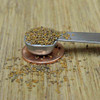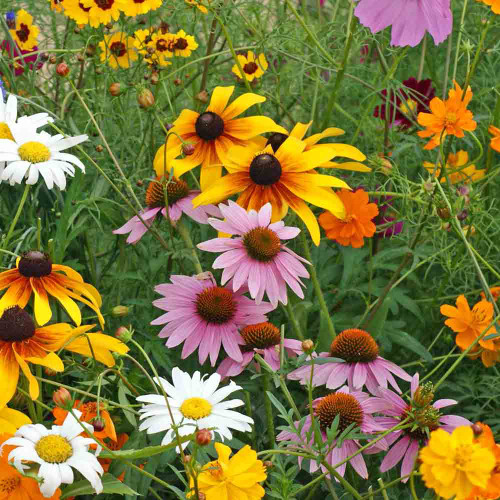Description
Wild Italian Arugula - The Authentic, Slow-Grown Flavor of the Italian Countryside
Wild Italian Arugula is a piece of the Mediterranean landscape you can plant in your garden, a flavor far removed from the mild, uniform greens of the supermarket. Thriving for centuries along sun-drenched roadsides and in the wild fields of the Italian countryside, this plant developed an intense, complex flavor—a robust profile of peppery spice and rich nuttiness. This is the authentic, genuine green Italians have foraged for generations, and it solves the single greatest frustration gardeners have with its domesticated cousin: its fleeting nature. Unlike the familiar annuals that bolt at the first sign of heat, this resilient, perennial species returns season after season, asking for little but offering an abundance of flavor.
Details
Wild Italian Arugula is an entirely distinct species from the familiar, annual common Rocket Arugula, not simply a wild version. This is a perennial species that distinguishes itself with deeply serrated, lance-shaped leaves and a slower, more deliberate growth habit. This develops its signature flavor—an intense, complex, and nutty-peppery spice without the harsh bitterness that can plague other greens. As a perennial, it establishes a deep taproot that allows it to access moisture and nutrients deep in the soil, contributing to its notable drought tolerance. It returns year after year in zones 5-9, forming a robust clump that can be harvested for months on end.
Gardeners often describe the dark green leaves as resembling an elongated oak leaf, with a more feathery, serrated, and delicate appearance than the broader leaves of common arugula. This gives them a firm, crisp texture and a delicate mouthfeel that holds up well in salads. The plant's flavor directly reflects its growing conditions; it becomes stronger and more pungent as the leaves mature or when the plant experiences heat or water stress.
The most striking difference is the flower. Wild arugula produces bright, clear yellow flowers, in contrast to the creamy-white flowers of common arugula, which feature dark purple or brown veins. These yellow flowers are also edible, possessing a spicy but milder flavor than the leaves. The plant itself emits a characteristic spicy and peppery aroma, and gardeners consistently describe the flavor as more assertive and complex than its annual cousin. While "peppery" is the common descriptor, tasting it reveals a rich nuttiness, a bright tang, and a spicy kick with notes of mustard and even a horseradish-like heat.
This variety is outstanding for container gardening. Its compact growth habit and tolerance for less-than-ideal conditions make it perfect for patios and urban gardens. A container at least 6 inches deep and 12 inches wide will provide adequate space, as long as it has excellent drainage and a high-quality, compost-rich potting mix. Its long history has given it a host of common names, including Perennial Wall-rocket, Wild Rocket, Sylvetta, and Roquette.
History
The use of arugula dates back to antiquity; the Old Testament mentions it, and ancient Greeks and Romans valued it for its flavor and perceived medicinal properties. It is native to the Mediterranean basin, Western Asia, and Europe, thriving as a ruderal species—a term for a hardy plant that is the first to colonize disturbed soils—along roadsides, on old walls, and in the wild fields—a tenacious plant. It is the type of arugula one can still find growing wild in the countryside around Rome.
For centuries, this rugged green was not a cultivated crop but a foraged treasure, known in the Italian countryside as Rucola selvatica. Its persistence in the regional food culture is a direct reflection of a flavor so compelling that people never forgot it. To meet global demand, breeders developed and domesticated a faster-growing annual cousin, known as Rocket Arugula. The wild species, by contrast, was never domesticated in the same way, retaining its complex, robust flavor and its innate resilience. Growing this variety is an opportunity to experience the authentic, genuine original that made arugula worth eating in the first place.
Wild arugula remained a foraged green, which an entire food culture preserved for its intense flavor. Its "breeder" was the Mediterranean ecosystem itself, and its "curators" were the generations who foraged it.
The plant's name traces its migration through European cultures. The Latin "eruca" became "rucola" in Italian, which immigrants carried to the United States.
Uses
The rich, nutty spice of this arugula holds its own in any dish. The leaves are firm enough to stand up to warm dressings, and you can wilt them into pasta or scatter them over a hot pizza, releasing their peppery aroma without disintegrating. Raw, it is a foundational ingredient in salads, pairing beautifully with acidic elements like citrus or balsamic vinaigrette, and rich components like nuts, prosciutto, and hard cheeses.
Heat mellows the sharp, peppery flavor, bringing forward more of its inherent nutty qualities. Chefs traditionally toss it into pasta at the last moment or lightly sautéed with garlic and olive oil as a side dish.
Companion Planting
This arugula grows well alongside other Mediterranean herbs like rosemary, thyme, and oregano, which appreciate similar sunny, well-drained conditions. Planting it near members of the onion family, such as chives or garlic, can help deter some common garden pests. Keep it away from other Brassicas, as they can attract shared pests.
Beyond simple pairing, this plant actively enhances the garden ecosystem. Its bright yellow flowers are a rich source of nectar and pollen, highly attractive to honeybees and beneficial syrphid flies (hoverflies). Attracting hoverflies is especially valuable, as their larvae feed extensively on aphids. Allowing a patch of wild arugula to flower is a strategic choice to support the beneficial insects that protect other crops. Furthermore, its tough taproot breaks up compacted soil, improving aeration and water infiltration, and can draw up minerals from the subsoil, enriching the topsoil as the leaves decompose.
Planting and Growing Tips
This variety's greatest strength is its forgiving nature. It thrives in conditions that would cause other greens to struggle, tolerating lean soil and dryness once established. Its self-sufficient character is remarkable; we had a patch in a container on our back deck that set seed, with some escaping under the deck. Now, years later, a small, thriving colony of wild arugula persists there with no watering, care, or attention, yet it still provides leafy harvests.
One of its most significant advantages is its superior heat tolerance. It is much slower to bolt in response to heat, which dramatically extends its harvest period. While it tolerates poor, sandy, and even rocky conditions, it is most productive in fertile, well-drained loam. Full sun (6+ hours) is preferred, but in regions with intense summer heat, providing afternoon shade is a highly effective strategy to keep leaves tender and delay bolting.
Consistent moisture is essential for the best flavor, though its deep taproot makes it significantly more drought-tolerant than its annual cousin once established. Direct sowing is strongly recommended, as transplanting easily damages the plant's taproot. Sow the small seeds shallowly (1/8 to 1/4 inch) in early spring, as soon as the soil can be worked; seeds can germinate in soil as low as 40°F.
In Zones 6–10, you should grow it as a true perennial, dying back after a hard freeze and returning vigorously in the spring. In Zone 5 and colder, treat it as an exceptionally hardy annual that can be sown weeks before other greens and will produce long into the autumn.
Harvest Tips
Begin harvesting the outer leaves when they reach 3-4 inches long. This "cut-and-come-again" method encourages a continuous supply of new, tender growth. For milder, tender "baby" leaves, harvesting can begin in as few as 21 to 40 days. For a more robust, peppery flavor, allow leaves to mature to 4-6 inches.
The ideal time to harvest is in the cool of the early morning or late evening, when the leaves are fully hydrated and crisp. Using scissors, snip the outer leaves about one inch above the soil, leaving the central crown intact. Never remove more than one-third of the plant at a single harvest. To store, wash the leaves, dry them thoroughly, wrap them loosely in a paper towel, and place them in a bag in the crisper drawer.
Learn More
- Cool Season Vegetables to Love
- Succession Planting - Boosting Garden Production
- Hortopita or Greek Spring Greens Quiche
From the soil to the seed to the food you eat - we'll help you grow your best garden!
3 Reviews
-
Wild is the best!
Love this stuff. Will never go back to the regular arugula. Has very strong arugula flavor with out being to peppery. Not bitter at all. Soft silky leaves that are narrower but thicker and juicier. Very cold hardy. Will be a mainstay in my garden.
-
best arugula
This arugula is so good. They survive cold winters - very hardy. We look forward to them each spring. One plant that is allowed to bring flowers will assure next years arugula in a very large area - if you let it. We work very hard to keep up with eating this delicious green.
-
My second review - 5 stars again
I reviewed this not too long ago after growing it in the winter. It came back with a vengeance this summer under the shade of my squash leaves. It had a totally different flavor in the heat of the summer. It was till very tender and succulent but very strong and peppery, even a bit spicy. I like the way it came out in either season. It spreads fast. It is basically a weed and will turn up in many places if left to go to seed.



















